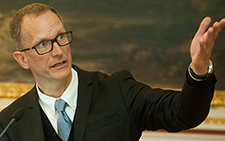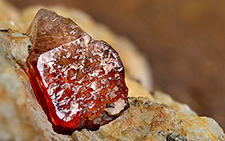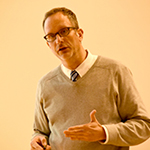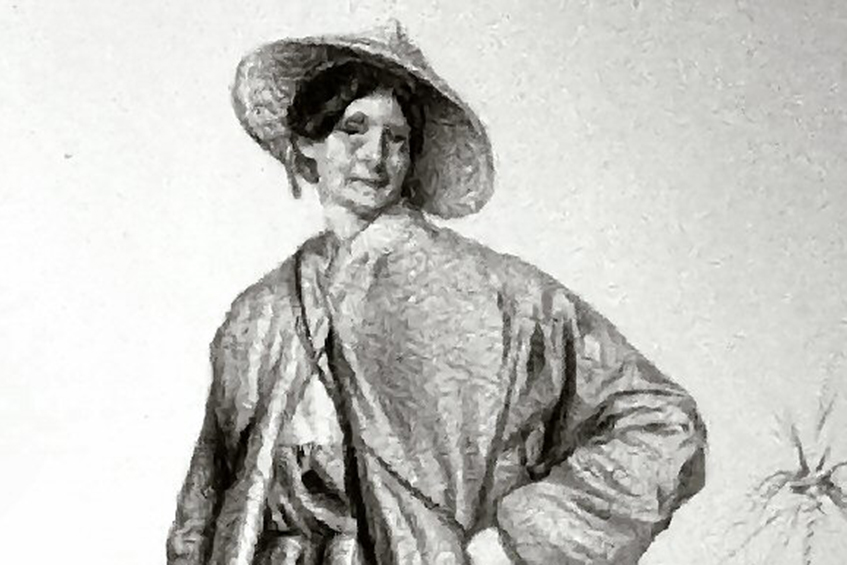"The water we drink is as old as Earth itself"
"The water we drink is as old as Earth itself"
19.05.2021

Stephen Mojzsis. Photo: Hungarian Academy of Sciences
Currently visiting: In March 2021, Stephen Mojzsis joined the Faculty of Earth Sciences, Geography and Astronomy as Ida Pfeiffer Professor. In his work, the Professor of Geology at the University of Colorado explores the fundamental physical and chemical aspects that govern the potential for a planet to harbor life in our solar system and beyond, with an eye towards exoplanets. Back on Earth, he studies the formation of our planet in its first 600 million years during the so-called Hadean eon and how it subsequently evolved to its present state. In his analyses, he also revealed that water existed even during these early times of Earth - and possibly also life.
- As geologist who uses physical, chemical and astronomical tools to understand Nature, your principal concentration is on the analysis of ancient rocks and meteorites - some of the oldest materials in our solar system. How old was the oldest one and what did it tell you?
Stephen Mojzsis: The only direct information we have about the earliest times in our solar system is the history of processes locked in the oldest rocks and minerals. On Earth, my team and I have documented zircons that formed within the first 100 million years of our planet’s existence. The story they tell us is that liquid water and continental-type rocks (granite) were both already present early on. With regards to meteorites and lunar samples, we have found that the conditions for life in the first few hundred million years of the solar system were relatively favourable, which could be good news for the search for life on places like Mars.

Not diamonds, zircons are forever: By analysing these "geological time capsules" Stephen Mojzsis found out, that water existed on Earth already 4,38 billion years ago. Photo: Martin Heigan on Flickr, CC 2.0.
- In some of your studies you rely on the analysis of zircon - why is this crystal so important?
Mojzsis: You remember the phrase “Diamonds are forever”? Well it turns out that it would be more true to say “Zircons are forever!” These minerals are interesting and important because they are resilient to geological processes like melting, metamorphism and erosion, that would normally destroy a mineral. Owing to this robustness, tiny zircons - no larger than a sand grain - can survive for a very long time, and retain chemical and isotopic information about how and when and under what crustal conditions they formed. This means that we have a kind of geological “time capsule” that we can consult to find out the chemical geodynamic regimes of the very early Earth. Yet, the oldest grains are also the rarest, so it is a challenge to find them; only a few rock outcrops in the world are known to host the oldest zircons, and these are in Western Australia, and, recently discovered, in South Africa.
- Some years ago, you discovered - also by analysing a zircon - that water existed in the earliest time of our Earth, about 4.4 billion years ago. How did this discovery change the view of the Hadean eon, the first eon of Earth’s geologic history?
Mojzsis: Previously, it was thought that the Hadean eon was typified by a hellish landscape of blasted and melted rocks with no potential whatsoever for liquid water, or for that matter, life. All of that changed abruptly when our analyses of zircon grains up to ca. 4.38 billion years in age showed that they had geochemical features consistent with a granitic crust bathed in water. It turns out that the old Hadean view was based entirely on speculation: We have come to understand that the Hadean was more like the eponymous Hades - in Greek mythology, a cold, dark and mysterious place - rather than the Hell in Judeo-Christian thought, a hot and sinister realm for damned souls. The challenge before us now is to understand what this means for the emergence of life on Earth, and to ask ourselves, what happened to Venus? To Mars?
Earth's First Rocks - National Geographyic about Stephen Mojzsis research
- How and when did water actually emerge at or reach our planet?
Mojzsis: Searches in the oldest geological records are much like paleontology: The oldest fossil you find is not necessarily the first appearance of that organism! As such, although the earliest evidence for water on Earth is about 4.4 billion years old, it merely tells us that water was present some time before that. Other studies, that compare Earth’s water with that of comets and the different groups of meteorites which comprised the building blocks of the planets, indicate that our planet’s water was delivered during formation and not later. The water we drink is as old as the Earth itself!
- You were also simulating the impact of the so called Heavy Bombardment – a period of time when a large number of asteroids collided with the early terrestrial planets in the inner Solar System. What did these simulations tell you about the origin of life on Earth?
Mojzsis: This is a fun question, because it happens that I am teaching a Master’s Course here at the University of Vienna on the topic of “Late Accretion”. We term it so because our understanding of bombardment has evolved to the point that most agree that there was heavy bombardment by asteroids and comets in the earliest days as a consequence of the leftovers being swept up by planet formation, but thermal models of these impacts show that although they were devastating, under no scenario can the biosphere be extinguished. That is something heart-warming to know! At our current state of knowledge, there seems to be nothing to prevent the emergence of life on Earth within the first 100 million years of our planet’s birth. How old, then, is the biosphere? The consensus being reached is that lifeforms have been here at least 4 billion years (or 1/3 the age of the Universe). Let that sink in.
- In your Master course on Late Accretion in the Solar System and the Heavy Bombardment, which central message should your students remember?
Mojzsis: I enjoy teaching this class very much, because it is not a “lecture” so much as a “conversation” and a celebration of ideas. I have participants coming not just from the cohort of students, but research professionals join in the Moodle-verse via the ZOOM platform as guests from throughout the University of Vienna and abroad. The take-home message from a course such as this one is “Do not be afraid to ask questions”. We are learning together about how little we actually know about the nascent solar system, and what are some ways we can find to shed more light on this dark, mysterious time?
The Hadean Earth vs. the Origin of Life - Talk by Stephen Mojzsis
- Why did you - back in autumn last year - decide to apply as Ida Pfeiffer Professor and join our Faculty, even in COVID-times?
Mojzsis: I had the honor of participating in a workshop two years ago at the Erwin Schrödinger Institute here in Vienna that was organized by faculty colleagues at the University of Vienna, namely Manuel Güdel, and Theresa Lüftinger at the Department of Astrophysics. During my time, I learned of this fabulous program to spend five months in Vienna. Jumping at the chance, I wrote a proposal to participate in what is a highly competitive selection process. Then, as now, I am delighted that I was chosen to visit.
Have your expectations been met so far?
Mojzsis: An important thing that I try to remember is that we should enter commitments with an open mind, and not create various expectations. Having visited Vienna many times over the years, I and my family have grown to love the city and its people. Of course, the pandemic has curtailed many activities – especially social gatherings – that would have been a normal part of my visit. What I have enjoyed a lot since coming here is the quiet peace of being allowed to work, to write and to think; this is something that I have not enjoyed for a very long time. The Ida Pfeiffer Professorship is a fantastic luxury for someone like me, and once again, I am grateful to have been selected.
The Ida Pfeiffer Professorship of the Faculty of Earth Sciences, Geography and Astronomy supports our mission to conduct excellent research on the sustainability of Planet Earth. Since 2018, the Faculty has been inviting scientists for one semester to trigger exciting research as well as teaching and act as a catalyst in the wide range of research topics addressed at the Faculty. Image: Ida Pfeiffer, Lithography by Adolf Dauthage
Thank you & welcome to our Faculty!

Stephen Mojzsis is Professor of Geology at the University of Colorado (Boulder, USA), and Institute Director of Geoastronomy in Budapest (Hungary). His work explores the fundamental physical and chemical aspects that govern the potential for a planet to harbor life in our solar system and beyond to exoplanets. Back on Earth, he leads field studies of early Archean terranes (Greenland, Canada, Australia) and studies ancient meteorites to understand the properties of the early solar system at the time the planets formed. Mojzsis uses methods in geochronology and crystal chemistry with various isotopic techniques applied to minerals and rocks; recent work investigates pre- and post- closure temperature thermal chemical diffusion modeling of accessory minerals to track late accretion, and to constrain dynamical models. In the Ida Pfeiffer Professorship, Stephen teaches a course on Late Accretion, and studies the origin of the inner vs. outer solar system isotopic dichotomy.
Working group / host professor at our Faculty: Christian Köberl
Courses in the summer term 2021: Late Accretion in the Solar System
Stephen Mojzsis - Geological Sciences, University of Colorado Boulder
- Recommended publications:
- Morrison, P. and Mojzsis, S.J. (2021) Tracing the early emergence of microbial sulfur metabolisms. Geomicrobiology Journal.
- Ritson, D.J., Mojzsis, S.J., Sutherland, J.D. (2020) Supply of phosphate to early Earth by photogeochemistry after meteoritic weathering. Nature Geosciences.
- Brasser, R. and Mojzsis, S.J. (2020) The inner and outer solar system was partitioned by a structured protosolar disk. Nature Astronomy.
- Benner, S.A., Bell, E.A., Biondi, E., Brasser, R., Carell, T., Kim, H-J., Mojzsis, S.J., Omran, A., Pasek, M.A., and Trail, D. (2020) When did Life Likely Emerge on Earth in an RNA-First Process? ChemSystemsChem 2, e1900035.
- Mojzsis, S.J., Brasser, R., Kelly, N.M., Abramov, O., and Werner, S. (2019) Onset of giant planet migration before 4480 million years ago. The Astrophysical Journal, 881:44 (13pp), 2019 August 10

